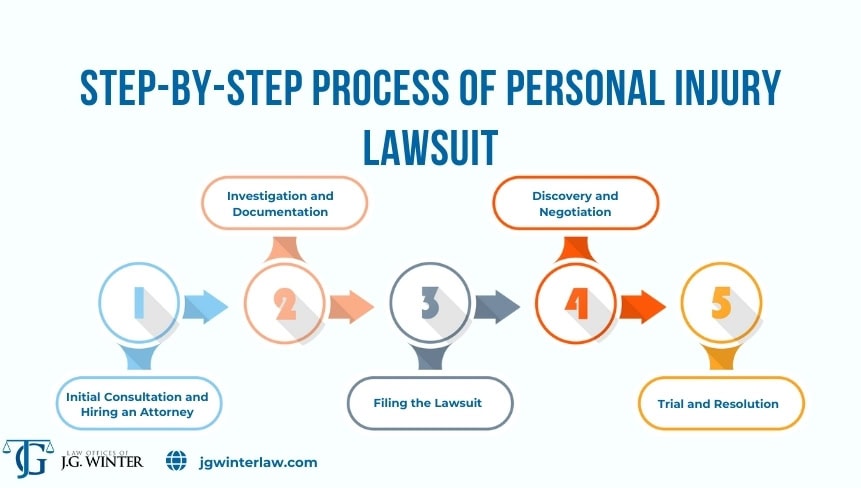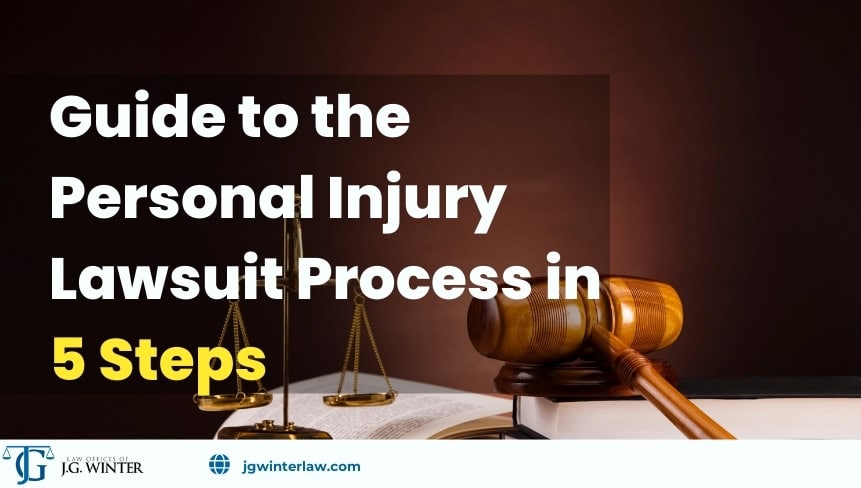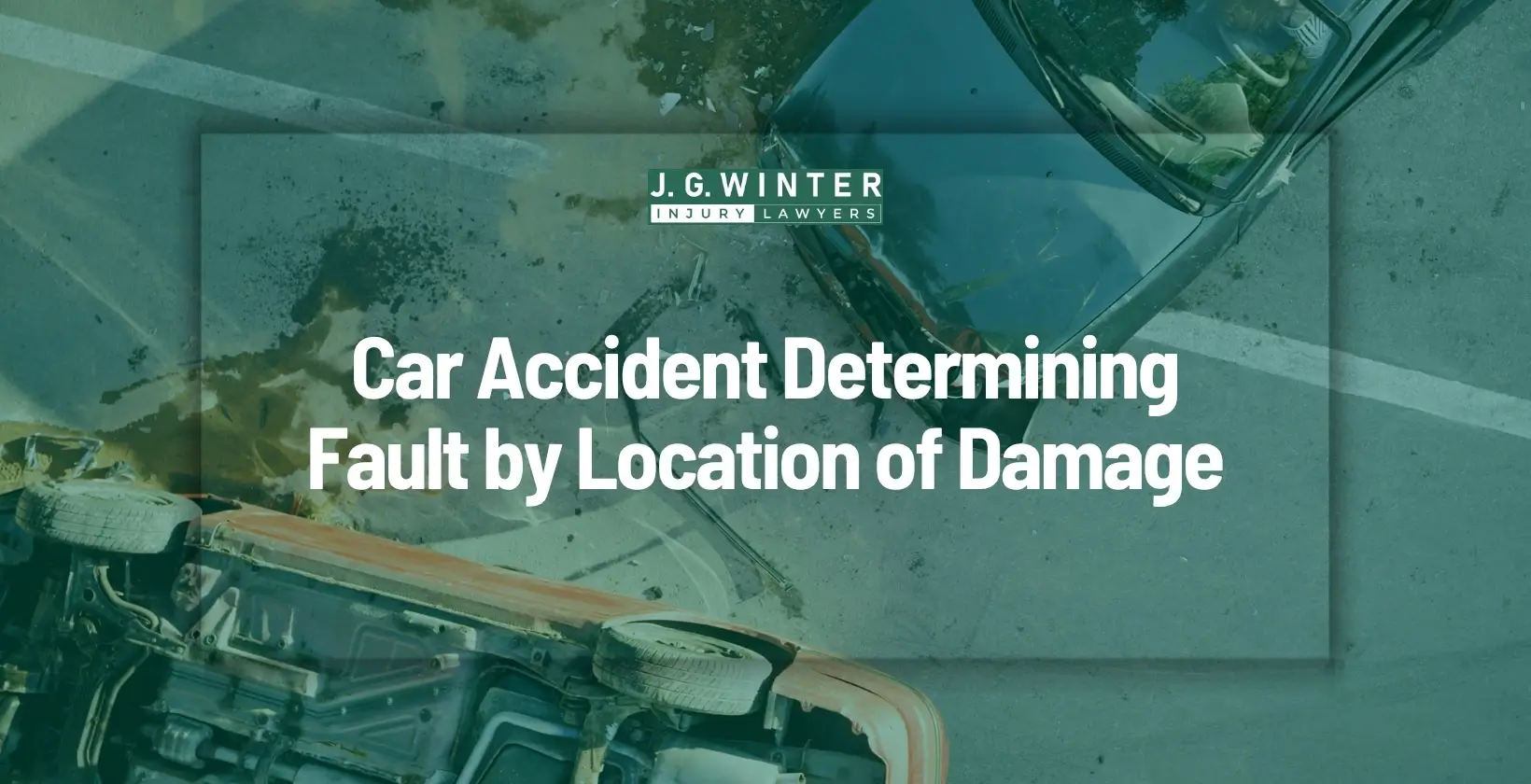Pursuing a personal injury lawsuit can seem daunting, but securing justice and compensation after an injury is crucial. The process holds responsible parties accountable and helps victims recover costs associated with medical bills, lost wages, and other damages.
Understanding personal injury lawsuit process, from initial consultation to trial and resolution, helps you make informed decisions about your legal rights and options. We guides you to the personal injury lawsuit process, helping you achieve a favorable outcome. Our personal injury lawyer covers every lawsuit and provides the best legal representation.
What constitutes a personal injury lawsuit?
A personal injury lawsuit arises when another person is legally responsible for an individual’s suffering and injury. These cases are built on the foundation that the injured party, known as the plaintiff, has suffered losses due to the defendant’s negligence or intentional act.
The personal injury lawsuit process allows you to seek compensation for damages such as medical bills, lost wages, and pain and suffering. It aims to recover financially and emotionally from their injuries.
The step-by-step process of personal injury lawsuit

Navigating the personal injury lawsuit process can be challenging, especially if you’re unfamiliar with personal injury laws like how long you have to file a personal injury lawsuit. These cases often involve complex legal procedures and require detailed documentation to prove your claim.
Understanding the steps to pursue a personal injury claim prepares you for what’s ahead and make informed decisions about your case. Each step builds your case effectively for a successful outcome.
Step 1: Initial consultation and hiring an attorney
The process of personal injury lawsuit begins with a crucial first step: the initial legal consultation and hiring an attorney. It lays the foundation for your legal pursuit, clarifying on your rights and the strength of your claim.
1.1 Initial legal consultation
Your first meeting with a potential attorney, where you discuss the specifics of your case, share evidence, and explore the feasibility of your claim. It helps you understand the legal process and set realistic expectations.
1.2 Choosing the right attorney
Look for a personal injury attorney who is empathetic, is excellent communicator, and has a compatible approach to handling your case. The right fit is crucial for a comfortable attorney-client relationship.
1.3 Understanding the attorney-client agreement
An agreement with your lawyer outlines the terms of your representation, including fee structures (contingency fee basis or hourly rates), attorney responsibilities, and client obligations. Thoroughly review and understand the agreement before signing.
Step 2: Investigation and documentation
After hiring a personal injury attorney, the next step is the investigation and documentation stage. It involves collecting all the necessary evidence to build a strong case.
2.1 Gathering evidence
Your attorney collects all available evidence related to the incident. It includes photos of the accident scene, witness statements, and any surveillance footage that might have captured the event.
2.2 Medical records
Medical records detail your injuries and outline the treatment received and any future medical needs. A personal injury lawyer serves as a basis for calculating damages.
2.3 Police reports
If the injury resulted from a traffic accident, a police report can provide an objective third-party account of the incident, which can be invaluable in establishing fault.
2.4 Documenting damages
You must document all other damages incurred, such as lost wages, property damage, and any other economic losses. It ensures that all potential areas of compensation are covered.
Step 3: Filing the lawsuit
After the documentation, the process continues with officially filing the lawsuit. It is the formal start of legal proceedings against the party or parties responsible for your injuries.
3.1 Drafting the complaint
The first official document in any lawsuit is the complaint. Your attorney drafts the document, which outlines your case against the defendant(s), including the facts of the case, the legal basis for the claim, and the damages sought.
3.2 Filing the complaint
Once the complaint is prepared, your attorney file it with the appropriate court. Filing fees are usually required, and the court then assigns a case number, marking the official start of your lawsuit.
3.3 Serving the complaint
The defendant is then formally notified of the lawsuit. The process is called “service of process,” where the complaint and a summons (a court-issued document) are delivered to the defendant. It ensures the defendant is aware of the lawsuit and has an opportunity to respond.
3.4 Awaiting the defendant’s response
The defendant has a specific timeframe, usually 20 to 30 days, to file a response to the complaint. They can admit or deny the allegations, which may also raise defenses or counterclaims.
3.5 Court scheduling
After filing a complaint and receiving the defendant’s response, the court will establish a schedule for the case. This schedule will set deadlines for the completion of discovery, submission of motions, and potentially, the trial date if the case proceeds to that stage.
Step 4: Discovery and negotiation
In the fourth step, both parties thoroughly understand the case’s facts and work towards a resolution, potentially without going to trial.
4.1 Discovery
The discovery phase allows the plaintiff and the defendant to gather detailed information from each other to build their cases. It includes exchanging documents, answering written questions (interrogatories), and depositions.
4.2 Medical records review
Attorneys request and review medical records to establish the extent of injuries, treatment received, and the prognosis. It helps determine the compensation amount.
4.3 Negotiation
Parties engage in negotiations to reach a settlement. Negotiations can occur at any time but are more common after the discovery phase when both sides have a clear understanding of the case’s strengths and weaknesses.
4.4 Mediation
If negotiations stall, a neutral third party, a mediator, can be brought in to facilitate a settlement. Mediation is non-binding but can help parties find common ground.
4.5 Settlement offers
Throughout this process, either party can make settlement offers related to personal injury claims. If an agreement is reached, it can avoid the need for a trial, saving time and expenses for both sides involved in the personal injury case.
Step 5: Trial and resolution
The journey through a personal injury lawsuit concludes with the trial and resolution phase, marking a pivotal moment where the case is presented before a judge or jury. The stage is the culmination of all prior preparation and efforts, spotlighting the evidence, arguments, and legal strategies developed along the way.
5.1 Jury selection
The trial starts with jury selection, where attorneys from both sides select jurors who will hear the case impartially.
5.2 Opening statements
Both parties present their opening statements, outlining their version of events and the evidence lawyer plan to present.
5.3 Presentation of evidence
The plaintiff and defendant take turns presenting evidence, including witness testimonies, expert opinions, and physical evidence, to support their claims or defense.
5.4 Closing arguments
Both sides make closing arguments, summarizing the case and urging the jury towards a verdict in their favor.
5.5 Jury deliberation and verdict
The jury deliberates on the evidence and arguments presented, ultimately reaching a verdict. They decide on liability and, if applicable, the amount of compensation the defendant must pay the plaintiff.
5.6 Resolution and appeal
Depending on the verdict, the case may conclude with the awarding of damages to the plaintiff. However, the defendant can appeal the decision, extending the resolution process.
Things to avoid during personal injury lawsuit process
During a personal injury lawsuit, certain actions can jeopardize your case, affecting the outcome and potential compensation. Adhering to the following guidelines can significantly influence your personal injury lawsuit’s success.
Discussing your case on social media: Sharing details about your case on social media can provide the defense with information to counter your claim. Keep details private to protect your case because social media can affect your personal injury claim.
Ignoring doctor’s advice: Failing to follow medical advice or missing appointments can be used to argue that your injuries are not as severe as claimed.
Accepting a quick settlement: Quick settlement offers may not fully cover your long-term needs or the true value of your claim. Consult with your attorney before accepting.
Exaggerating injuries: Overstating the extent of your injuries can undermine your credibility and negatively impact your case’s integrity.
Providing statements to other party’s insurance: Speaking directly to the defendant’s insurance company without legal representation can lead to unintentionally damaging your case. Let your personal injury attorney handle communications.
J.G. Winter Law for personal injury lawsuit
Navigating the personal injury lawsuit process appropriately is important to secure maximum compensation for your injuries. From the initial consultation to the final resolution, every step requires careful attention to detail and adherence to legal procedures. An experienced personal injury attorney can guide you through each step and advocate.
J.G. Winter Law supports you through the complexities of personal injury claims, fighting for the best possible outcome in your case. If you or a loved one has been injured, contact us today to navigate your legal journey.
FAQs
Should I make a personal injury claim?
If you’ve been injured due to someone else’s negligence or intentional act, making a personal injury claim can help you receive compensation for your losses. Consult with a personal injury attorney to assess your situation and advise on the best course of action.
What are the stages of an injury claim?
An injury claim typically progresses through several stages:
- Initial consultation with an attorney
- Investigation and documentation of the claim
- Filing the lawsuit
- The discovery phase, negotiation and mediation
- Trial and resolution
What are the basic principles of personal injury?
The basic principles involve proving that the defendant had a duty of care towards the plaintiff, breached that duty, directly causing harm or injury, and as a result, the plaintiff suffered damages or losses.
How do I claim compensation for personal injury?
To claim compensation for personal injury, you should consult a personal injury attorney to evaluate your case. They guide you through filing a claim, including gathering evidence, documenting injuries and losses, negotiating with insurance companies, or proceeding to trial if necessary.
What are personal injury damages awarded?
Personal injury damages can include economic damages (medical bills, lost wages), non-economic damages (pain and suffering, emotional distress), and sometimes punitive damages intended to punish egregious behavior.
How much compensation do you get for personal injury?
Compensation for personal injuries can range from thousands to millions of dollars. It depends on the severity of injuries, impact on quality of life, and the defendant’s conduct.
How is compensation calculated?
Compensation is calculated by considering medical expenses, lost earnings, future financial losses, pain and suffering, and any other harm or losses incurred due to the injury.
What is personal injuries resolution?
Personal injuries resolution refers to resolving a personal injury claim, either through settlement negotiations outside of court or by a court decision during a trial.




